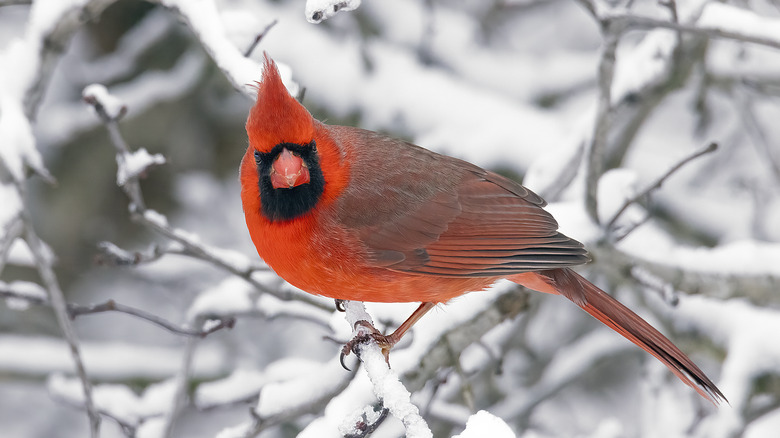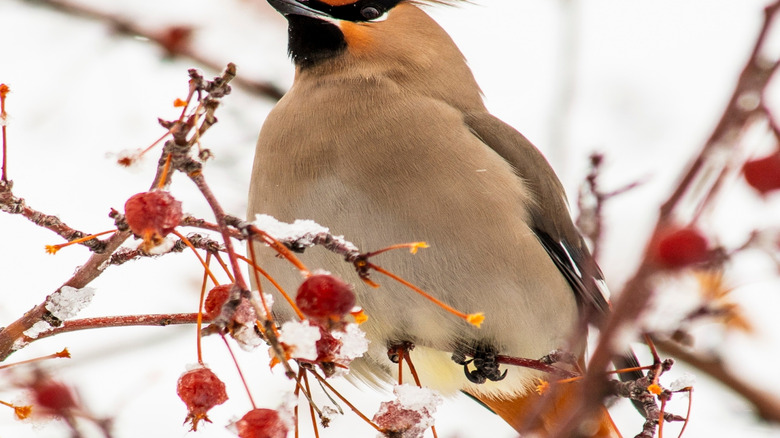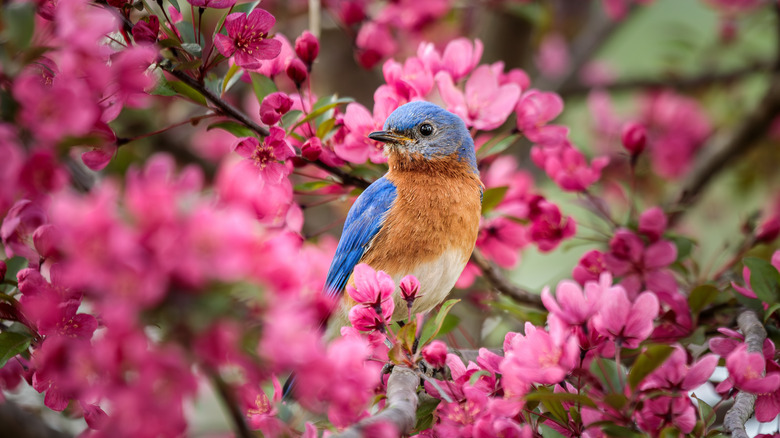The Fruit Tree That Will Attract Birds To Your Yard, Even In Winter
One of the best things about gardening is seeing all the wildlife flock to your yard when the plants begin to bloom. But when those summer blooms begin to fade, it doesn't have to mean the end of wildlife activity in your yard. In fact, you can plant one fruit tree that will keep birds hanging around throughout the seasons — the crabapple (Malus). There are many types of crabapple trees you can grow in your yard and each one has its own way of attracting birds, even in the snowy winter.
Crabapples are a flowering and fruiting tree that will thrive in clay soil, so they are a great solution for attracting birds in conditions where other fruit trees may not be an option. Since this low maintenance tree is easy to establish and produces flowers and fruit from spring to winter, it is ideal for gardeners looking to bring all sorts of birds to their yard. In the spring, you will find songbirds feasting on bugs and drinking nectar from the fresh blooms. If you choose the right variety, you can have a lasting bloom season that extends into the summer to keep these birds around. By fall, the tree will begin producing fruit, which will attract those hungry birds. Plus, the fruit stays around well into the winter, so expect to see cardinals and blue jays hanging around well past snowfall.
How to care for your crabapple tree for the winter birds
Tending to a crabapple tree is considered a low-maintenance task, but you'll still want to avoid the common mistakes. These versatile trees can grow in zones 3 to 9 (USDA) and reach a height of 14 to 44 feet. They are generally drought resistant but can be susceptible to insects and diseases like apple scab, though some varieties are more resistant to disease than others. Proper care begins with planting since placement is essential to promote growth. You will want to make sure that the tree has enough space to grow, about 25 feet, and gets full sun. They can tolerate some shade, but too much can lead to a host of issues that will deter birds, rather than attract them.
Once it is established, you will need to watch for disease and keep up with the pruning as a healthy tree will keep the birds coming back for more. The type of crabapple you plant will determine how susceptible it is to disease, but you'll still want to practice regular tree sanitation. This involves pruning harmful branches and removing leaves that could contain fungal spores. In the late winter or early spring, cut away crossing branches or those that are too close to each other on the tree trunk. You will also want to cut non-flower-producing branches that grow straight upward.
Birds you can expect to see feasting on your crabapples year-round
Songbirds are especially attracted to crabapple trees, and they love feasting on it year-round, but they aren't the only ones. Each season, new birds will forage for food among the branches of the crabapple trees. The variety of birds you see will depend on numerous factors, including migration patterns and weather conditions.
In the warmer months, you might see bright colored birds hiding in your trees. Crabapples are notable for attracting hummingbirds and other nectar feeders and pollinators when they begin to flower. You may also see finches, chickadees, mockingbirds, or warblers. In the colder months, you may find iconic winter birds flocking to your crabapple tree such as starlings, robins, cardinals, pine grosbeaks, woodpeckers, blue birds, and cedar waxwings. Of course, these are just a few birds that are commonly spotted in crabapple trees. The possibilities are endless.


